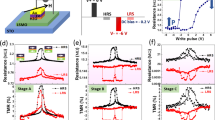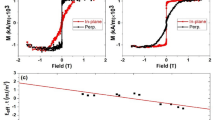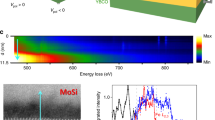Abstract
Creating temperature gradients in magnetic nanostructures has resulted in a new research direction, that is, the combination of magneto- and thermoelectric effects1,2,3,4,5. Here, we demonstrate the observation of one important effect of this class: the magneto-Seebeck effect. It is observed when a magnetic configuration changes the charge-based Seebeck coefficient. In particular, the Seebeck coefficient changes during the transition from a parallel to an antiparallel magnetic configuration in a tunnel junction. In this respect, it is the analogue to the tunnelling magnetoresistance. The Seebeck coefficients in parallel and antiparallel configurations are of the order of the voltages known from the charge–Seebeck effect. The size and sign of the effect can be controlled by the composition of the electrodes’ atomic layers adjacent to the barrier and the temperature. The geometric centre of the electronic density of states relative to the Fermi level determines the size of the Seebeck effect. Experimentally, we realized 8.8% magneto-Seebeck effect, which results from a voltage change of about −8.7 μV K−1 from the antiparallel to the parallel direction close to the predicted value of −12.1 μV K−1. In contrast to the spin–Seebeck effect, it can be measured as a voltage change directly without conversion of a spin current.
This is a preview of subscription content, access via your institution
Access options
Subscribe to this journal
Receive 12 print issues and online access
$259.00 per year
only $21.58 per issue
Buy this article
- Purchase on Springer Link
- Instant access to full article PDF
Prices may be subject to local taxes which are calculated during checkout




Similar content being viewed by others
References
Gravier, L., Serrano-Guisan, S., Reuse, F. & Ansermet, J. P. Thermodynamic description of heat and spin transport in magnetic nanostructures. Phys. Rev. B 73, 024419 (2006).
Uchida, K. et al. Observation of the spin–Seebeck effect. Nature 455, 778–781 (2008).
Slachter, A., Bakker, F. L., Adam, J. P. & van Wees, B. J. Thermally driven spin injection from a ferromagnet into a non-magnetic metal. Nature Phys. 6, 879–882 (2010).
Uchida, K. et al. Spin Seebeck insulator. Nature Mater. 9, 894–897 (2010).
Jaworski, C. M., Yang, J., Awschalom, D. D., Heremans, J. P. & Myers, R. C. Observation of the spin-dependent Seebeck effect in a ferromagnetic semiconductor. Nature Mater. 9, 898–903 (2010).
Czerner, M., Bachmann, M. & Heiliger, C. Spin caloritronics in magnetic tunnel junctions: Ab initio studies. Phys. Rev. B 83, 132405 (2011).
Bauer, G. E. W., MacDonald, A. H. & Maekawa, S. Spin caloritronics. Solid State Commun. 150, 459–460 (2010).
Johnson, M. & Silsbee, R. H. Thermodynamic analysis of interfacial transport and of the thermomagnetoelectric system. Phys. Rev. B 35, 4959–4972 (1987).
Müller, G. et al. Spin polarization in half metals probed by femtosecond spin excitation. Nature Mater. 8, 56–61 (2009).
Ikeda, S. et al. Tunnel magnetoresistance of 604% at 300 K by suppression of Ta diffusion in CoFeB/MgO/CoFeB pseudo-spin-valves annealed at high temperature. Appl. Phys. Lett. 93, 082508 (2008).
Heiliger, C., Czerner, M., Yu, Yavorsky, B., Mertig, I. & Stiles, M. D. Implementation of a non-equilibrium Green’s Function Method to calculate spin transfer torque. J. Appl. Phys. 103, 07A709 (2008).
Sivan, U. & Imry, Y. Multichannel Landauer formula for thermoelectric transport with application to thermopower near the mobility edge. Phys. Rev. B 33, 551–558 (1986).
Ouyang, Y. & Guoa, J. A theoretical study on thermoelectric properties of graphene nanoribbons. Appl. Phys. Lett. 94, 263107 (2009).
Lee, S. M., Cahill, D. G. & Allen, T. H. Thermal conductivity of sputtered oxide films. Phys. Rev. B 52, 253–257 (1995).
Thomas, A. et al. Direct imaging of the structural change generated by dielectric breakdown in MgO based magnetic tunnel junctions. Appl. Phys. Lett. 93, 152508 (2008).
Liebing, N. et al. Tunnelling magneto thermo power in magnetic tunnel junction nanopillars. Preprint at http://arxiv.org/abs/1104.0537 (2011).
Le Breton, J-Ch., Sharma, S., Saito, H., Yuasa, S. & Jansen, R. Thermal spin current from a ferromagnet to silicon by Seebeck spin tunnelling. Nature 475, 82–85 (2011).
Acknowledgements
A.T. acknowledges the Ministry of Innovation, Science and Research of the North Rhine-Westphalia state government for financial support. M.M., M.S., M.W. and P.P. acknowledge the funding provided by the German Research Foundation through the SFB 602 for the TEM work. M.C., M.B. and C.H. acknowledge support from German Research Foundation SPP 1386 and German Research Foundation grant HE 5922/1-1. J.S.M acknowledges support by the US National Science Foundation and Office of Naval Research. We acknowledge A. Zeghuzi’s help for extra COMSOL calculations. This work was initiated by the SpinCaT priority program.
Author information
Authors and Affiliations
Contributions
M.W. and J.W. carried out experiments; M.W., V.Z., M.Sch. and D.E. characterized and prepared the TMR devices; P.P. and M.S. carried out the high-resolution TEM; M.W., J.W. and M.M. analysed the data; M.W. carried out the COMSOL calculations; M.C., M.B. and C.H. did the ab initio transport calculations; A.T. and M.M. designed the research approach; C.H., M.M. and A.T. wrote the manuscript and developed the model; M.W., J.S.M., A.T., M.M. and C.H. contributed to the development of the experiments; G.R., J.S.M., A.T., M.M., C.H. and all authors discussed the experiments and the manuscript.
Corresponding author
Ethics declarations
Competing interests
The authors declare no competing financial interests.
Supplementary information
Supplementary Information
Supplementary Information (PDF 932 kb)
Rights and permissions
About this article
Cite this article
Walter, M., Walowski, J., Zbarsky, V. et al. Seebeck effect in magnetic tunnel junctions. Nature Mater 10, 742–746 (2011). https://doi.org/10.1038/nmat3076
Received:
Accepted:
Published:
Issue Date:
DOI: https://doi.org/10.1038/nmat3076
This article is cited by
-
Tunable magneto-Seebeck effect in Co2FeSi/MgO/Co2FeSi heterostructure via optimized interfacial engineering
Science China Physics, Mechanics & Astronomy (2024)
-
The role of spin in thermoelectricity
Nature Reviews Physics (2023)
-
Large Spin-Dependent Thermoelectric Effects in NiFe-based Interconnected Nanowire Networks
Nanoscale Research Letters (2020)
-
Record thermopower found in an IrMn-based spintronic stack
Nature Communications (2020)
-
Near-room-temperature spin caloritronics in a magnetized and defective zigzag MoS2 nanoribbon
Journal of Computational Electronics (2020)



